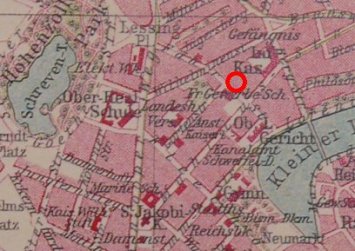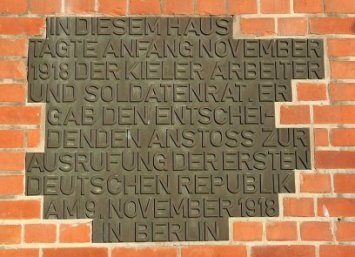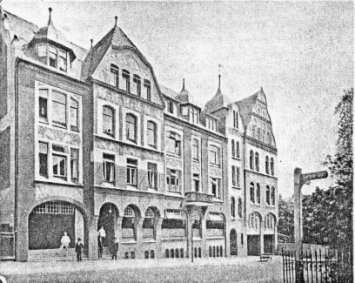Homepage Renate and Klaus Kuhl - Sailors' revolt in Kiel
Virtual Sightseeing Tour "Kiel Mutiny" Nov. 1918
[01] [02] [03] [04] [05] [06] [07] [08] [09] [10] [11] [12]
Nr. 08: Meeting of representatives of soldiers and workers in the union house on 4 November 1918, 20 hrs.
The union house has played a central role in the events. Already on 1 November 1918 the sailors, who wanted to liberate their arrested comrades met here. They then met several members of the workforce, including Lothar Popp from the USPD. At 4 November in the evening the famous Kiel 14 points were adopted here, which later served as a model for many other councils. Subsequently, the workers’ council met here and apparently also the soldiers’ council; the latter however, also met in the marine station Ostsee. In a flyer issued on 5 Nov. 1918, the Soldiers' Council announced: The office of the Soldiers' Council will be temporarily the union house room 13.
| Present days map | Former map |
|
Größere Kartenansicht |
 |
| A town map from 1910, the circle shows the place of the union house in the then Fährstrasse. | |
| Present day view | Former view |
 |
 |
| Plaque at the union house in Kiel, photo Wikipedia | Postcard ca. 1907. In a flyer issued on 5 Nov. 1918, the Soldiers' Council announced: The office of the Soldiers' Council will be temporarily the union house room 13. |
Further information:
The Kiel 14 points (translation by Klaus Kuhl and GHDI staff): "Resolutions and demands of the Soldiers’ Council (according to SPD newspaper VZ 5 November 1918):
- The release of all inmates and political prisoners.
- Complete freedom of speech and the press.
- The abolition of mail censorship.
- Appropriate treatment of crews by superiors.
- No punishment for all comrades on returning to the ships and to the barracks.
- The launching of the fleet is to be prevented under all circumstances.
- Any defensive measures involving bloodshed are to be prevented.
- The withdrawal of all troops not belonging to the garrison.
- All measures for the protection of private property will be determined by the Soldier’s Council immediately.
- Superiors will no longer be recognized outside of duty.
- Unlimited personal freedom of every man from the end of his tour of duty until the beginning of his next tour of duty.
- Officers who declare themselves in agreement with the measures of the newly established Soldier’s Council, are welcomed in our midst. All the others have to quit their duty without entitlement to provision.
- Every member of the Soldier’s Council is to be released from any duty.
- All measures to be introduced in the future can only be introduced with the consent of the Soldiers’ Council.
The Soldier’s Council.
Assessment by Dirk Dähnhardt in his doctoral thesis „Revolution
in Kiel“, Wachholtz Verlag, Neumünster, 1978:
"The 14 points of Kiel were ... mainly an attack on the military
system, political objectives were lacking widely." (Revolution
in Kiel, S. 91, translation KK) Dähnhardt attributes this on the
one side to the heterogenic composition of the bodies and on the
other side to the intention to first of all issue a catalogue
of immediate measures. Unfortunately during the following events
councils all over Germany orientated themselves on these 14 items.
In the political short sightedness Dähnhardt sees a major cause
that the soldiers’ councils were dissolved after six months.
The virtual sightseeing tour at a glance:
- Holtenau viaduct and locks >>
- Large drillground (Großer Exerzierplatz) >>
- Karlstraße / Langer Segen >>
- Torpedo workshop Friedrichsort, Germania shipyard Kiel-Gaarden >>
- Barracks (Kasernen) in Kiel-Wik >>
- Marinestation Ostsee >>
- Arrestanstalt (military prison >>
- Trade union house (Gewerkschaftshaus) >>
- Town hall (Rathaus) >>
- "Schloßhof" >>
- Station (Bahnhof) >>
- Graves of the killed revolutionaries and soldiers >>
Real, guided tours on this subject are offered by:
- Geo-Step-by-Step >>
- Ernst Mühlenbrink, via Society for Kiel's Town History
(Gesellschaft für Kieler Stadtgeschichte) >>
- AKENS, Asche Arbeitskreis >>
Last modified: 13 Nov. 2011
| Sailors' Revolt / Kiel Mutiny November 1918 - here you'll find the following further information:
|
